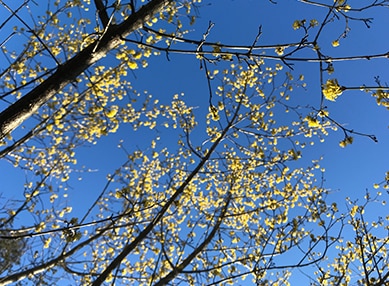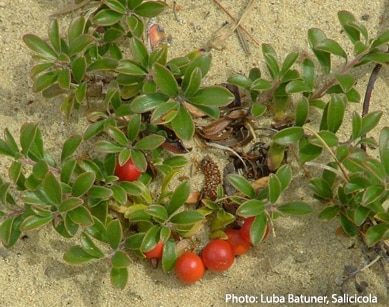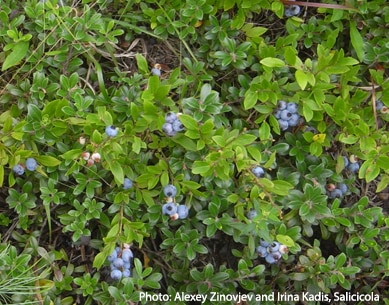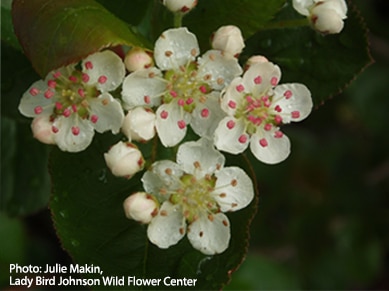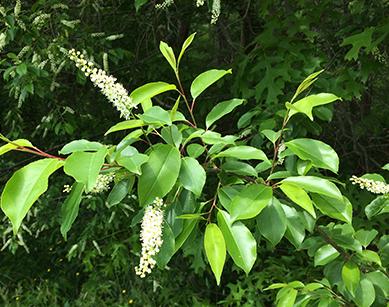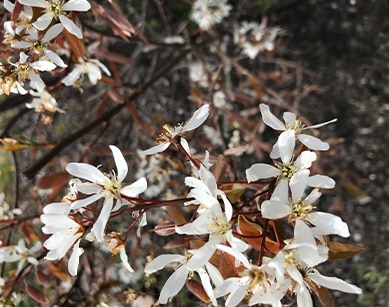Spring—tree buds bursting open with colorful blooms, bulb plants shooting up nobly through the ground, and new, soft, green growth emerging from the stems of shrubs and perennials. Having been inspired by the natural wonders of spring, you want to get out there and plant your own splendiferous garden, right? Well, if you live on the coast, you may need to consider a few extra particulars before you get started. Most importantly, you should choose native plants that are suitable for coastal conditions, such as salt spray, wind, and sandy and nutrient-poor soils. However, do not despair—many suitable choices of grasses, groundcovers, shrubs, and trees not only provide visual beauty, but also offer other benefits, such as wildlife habitat, pollution prevention, and even erosion control. And what's more, coastal homeowners benefit from the fact that coastal regions often warm up earlier in the spring and have a longer growing season than the interior parts of the state.
Check out the following facts and tips to find out more.
Climate on the Coast
Living close to the ocean has tremendous benefits, not the least of which is the climate. The temperature of the ocean can actually moderate air temperatures, minimizing extremes (high highs and low lows) because the ocean and the land near it heat up and cool down much more slowly than inland areas. (If you want to learn more about this process, see Water Encyclopedia's, Water as a Climate Moderator.) This moderate climate means a longer growing season. According to National Oceanic and Atmospheric Administration (NOAA), in Massachusetts, the growing season for plants that are subject to injury from freezing temperatures averages a mere 120 to 160 days inland, while it averages a plethora of 160 to 200 days on the coast. Moreover, the average date of last freeze for spring falls in the latter part of May in inland areas (who can wait that long!), while it falls as early as mid-April on a coastal site like Nantucket.
To find out more information about the climate of Massachusetts (PDF, 44 KB) and freeze/frost data (PDF, 13 KB), visit NOAA's National Centers for Environmental Information website.
Native Plants
When choosing plants for a coastal garden this spring, look for native plants that are well adapted to wind, salt spray, dry sandy soils, low nutrients, and even sand burial. These hardy plants not only thrive on the coast, they provide the added benefits of erosion control and stabilization of soils, a filter for pollutants, wildlife habitat, and beauty.
For example, this native of Massachusetts, common bearberry (Arctostaphylos uva-ursi 'Massachusetts'), with its leathery, dark, evergreen leaves, small white/pink urn-shaped flowers, and bright red berries is a popular groundcover/low shrub choice. Bearberry grows 6-12 inches high and spreads from 3-6 feet wide. Over time, bearberry can spread by stem rooting to cover a very large area of up to 15 feet wide. The small flowers bloom from April to May and bright red fruits appear from August through the winter. The fruit is eaten by a few species of songbirds and other wildlife. Bearberry has the added benefit of being a very effective stabilizer of steep slopes or exposed areas. See the National Wildlife Federation's American Beauties website for information on this particular bearberry variety.
Lowbush blueberry (Vaccinium angustifolium) is another appealing native deciduous shrub with a dark green leaf color, urn-shaped white flowers that bloom in May, and edible berries that mature in mid- to late-summer. The plant, which can grow 2 feet high and wide, thrives in full sun to partial shade, with more sun producing more blooms and more fruit. Lowbush blueberry attracts wildlife and can be useful in the landscape as a shrub border and as naturalized plantings. The lowbush blueberry page on University of Connecticut's Plant Database provides additional details on this exceptional plant. And as one final benefit, blueberries are touted as being one of the best antioxidants around—check out information on blueberries on WebMD's Health Cooking website.
Black chokeberry (Aronia melanocarpa) is another good native shrub choice due to its multi-seasonal qualities, including clusters of small white flowers in the spring, persistent fruit in late summer and autumn, high-quality leaves in the summer, and bright red foliage in the fall. This hardy multi-stemmed shrub grows 3 to 6 feet in height and width and tends to form broad thickets. The fibrous root system is very effective at holding soil and is therefore a good choice for erosion control. Black chokeberry is adaptable to many conditions, including sandy and rocky areas, dry or wet soils, and full sun or partial shade. The chokeberries provide ornamental interest through much of winter since the fruit are very astringent to birds and won't be eaten until other fruits are depleted. The University of Connecticut's Plant Database has a page devoted to black chokeberry.
Trees in the Spring
When it comes to springtime gardening inspiration, one can't help but immediately think of fruit trees blossoming with colorful and fragrant flowers. But native trees are not just pretty. They can reduce stormwater runoff by intercepting and storing rainwater in their root system. They can reduce soil erosion by slowing rainfall before it lands on the soil. They can also take up carbon dioxide while emitting oxygen—reducing greenhouse gases that lead to climate change—and improve general air quality by taking up other pollutants (see Global Warming for Dummies on page 75 of CZM's 2008 Coastlines magazine [PDF, 9 MB]). Planting a tree next to your house can enhance "curb appeal" while reducing your home heating and cooling costs by creating shade in the summer and reducing the impact of cold winds in winter.
If you choose to plant a tree in your yard, check out these two native spring beauties:
Black cherry (Prunus serotina) is a rapid-growing deciduous tree with a dense oval crown and elegantly swaying branches. This tree prefers deep, moist, fertile soil, but is tolerant of salt and drought and thrives in full sun to part shade. In the spring, black cherry produces fragrant white flowers on swaying stems. The berry-like fruits mature in the late summer and are important food for numerous bird species and mammals, including the red fox, black bear, raccoon, opossum, squirrel, and rabbit. Black cherry is an aromatic tree—the crushed foliage and bark have a cherry-like aroma. See the black cherry web page on the United States Department of Agriculture's (USDA) PLANTS Database and Gardening Know How's How To Grow A Black Cherry Tree for more information on this species and how to plant it.
Downy serviceberry (Amelanchier arborea) is a small deciduous tree that grows clusters of white flowers in April before the leaves appear. The oval leaves emerge a downy gray and mature to a dark green in the summer. The fall foliage is showy with orange, gold, red, and green. Downy serviceberry grows in a variety of habitats, including swamps, dry woods, sandy bluffs, rocky ridges, forest edges, and fields. Many bird species (such as cardinals, cedar waxwings, towhees, and Baltimore orioles) and mammal species (such as rabbits, mice, fox, black bears, and deer) eat the tart berries. The common serviceberry (AKA downy serviceberry) page on the USDA PLANTS Database gives additional details.
Additional Information
- Coastal Landscaping - This site by the Massachusetts Office of Coastal Zone Management (CZM) provides information on the benefits of landscaping coastal property with native, hardy, salt-tolerant plant species for the primary purposes of providing storm damage prevention and erosion control. The site includes plant lists, sample landscape plans, and photographs and detailed information on particular plant species.
- Blue Stem Natives - This site provides descriptions of native plants for New England, which can be searched for by interest (such as sustainability, wildlife, and beauty), targeted areas (such as shorelines and roadsides), or plant attribute (such as size, height, plant spacing, bloom time, and sun and water needs). The site also includes native plant resources, videos, a blog, and landscape design help.
- Cape Cod Native Plants - This online tool hosted by Association to Preserve Cape Cod (APCC) is designed to help gardeners on Cape Cod find native plants suited for specific sites and that complement their landscape design. Users can search for plants based on plant type, sunlight, soils, bloom month, size, and nature benefits. As part of their Native Plant Initiative, APCC also provides helpful resources, such as native garden design examples, Sources for Native Plants & Seeds (PDF, 134 KB), a List of Resources About Native Plants (PDF, 88 KB), and Recommended Presentations on landscaping with native plants (PDF, 104 KB).
- American Beauties Native Plants - This National Wildlife Federation website offers information on the collection of American Beauties Native Plants, including trees, shrubs, vines, grasses, and wildflowers, which provide wildlife habitat and beauty to the landscape. The site also provides design plans and plant lists for four distinct theme gardens—bird garden, butterfly garden, dry shade, and moist sun.
- Arbor Day Foundation - This website, provided by the nonprofit organization that is dedicated to planting trees, offers tree identification guides, descriptions and growth requirements of trees, care and maintenance guides, and information on the benefits of planting trees. The site also offers a Tree Nursery where you can choose from nearly 200 species of trees to buy and a Tree Benefit Calculator that calculates the benefits of the particular tree that you plant. The Arbor Day Foundation offers a variety of other programs and online information, such as on the Trees in Forests page, which covers their tree replanting efforts around the world, and on the Youth Education page, which provides online activities to help children and educators learn about trees and connect with nature. Everything you need to inspire the next generation of tree planters in your classroom.
- PLANTS Database - This database by the USDA Natural Resources Conservation Service (NRCS) provides plant descriptions, characteristics and classification, distribution, and images.
- University of Connecticut (UConn) Plant Database of Trees, Shrubs, and Vines - This site provides specifics on plant attributes—such as habitat, form, seasonal characteristics, culture, and landscape uses—accompanied by images.
- Connecticut Native Plant and Sustainable Landscaping Guide (PDF, 114 MB) - From the University of Connecticut Extension Program, this guide provides comprehensive lists, descriptions, and photos of native plants (for Connecticut), including native forbs that grow easily from seed, native perennials for garden beds or rain gardens, low-growing ground covers, low-maintenance and alternative lawn options, native forbs for meadows, salt tolerant and coastal plants, and much more.
Photos by CZM unless otherwise noted.
